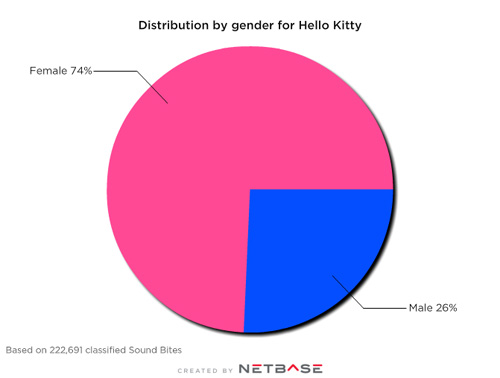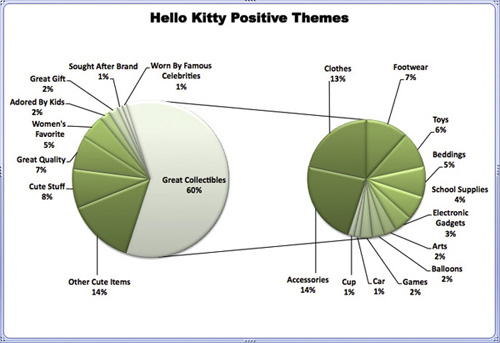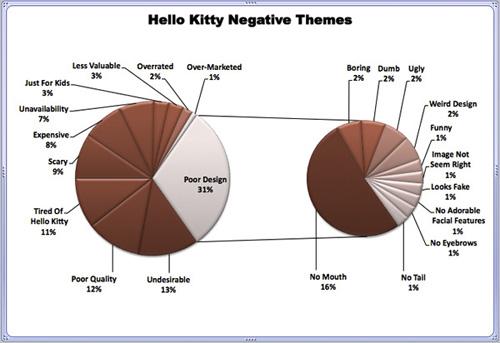How cute is too cute? That’s the question for the Hello Kitty brand. The main audience is “pre-teen girls,” and they find Kitty, the white Japanese bobtail cat with a red bow, to be so adorable. However, not everyone buying the products shares the same love for the kitten.
About Sanrio
The company that created Hello Kitty is SANRIO, and this year it marks its 50th anniversary. Hello Kitty, whose full name is Kitty White, is a character that was first created by Yuko Shimizu. She made her debut on a vinyl coin purse that was launched in Japan in 1974 and arrived in the United States in 1976. According to Wikipedia, Sanrio has generated over $1 billion each year in sales of Hello Kitty products outside Japan since 2003. The Hello Kitty product line includes everything from purses, stickers, and pen sets to toasters, TVs, clothing, massagers, and computer gear. There are also two officially licensed Hello Kitty theme parks: Harmonyland and the indoor Sanrio Puroland.
About the Hello Kitty Audience
We used NetBase’s gender classification technology to draw this chart based on all comments about Hello Kitty over the past year. It shows the overwhelmingly female make-up of online posters about this brand.
Positive Themes
Consumers find that Hello Kitty items make “great collectibles,” and particularly like accessories, clothes and footwear. (It’s not possible to know the ages of the posters, but most of the positive comments seem to come from young girls and sometimes from their moms.)
- I also want to get a Hello Kitty coloring book and the biggest pack of crayons! (source)
- Love my Hello Kitty Vans and my necklace. (source)
- I love my new Hello Kitty pajamas. Thanks, Dad. (source)
Shoppers also like the “other cute items” Hello Kitty sells.
- kojimin asked: I bought Haruko a Hello Kitty plushy. She sleeps with it every night. Makes me smile. (source)
- The love of my life doesn’t need to buy me Chanel, LV, or any expensive brand names…I just want him to buy me Hello Kitty… (source)
- I’m loving this Hello Kitty theme on my iPhone…..it’s soooo cute! (source)
“Great quality” shows up in the positive themes, but we’ll see other opinions on quality in the negative themes.
- My Hello Kitty blanket is soooooo soft (: aha. (source)
Negative Themes
Many consumers feel the products have a “Poor Design,” and cite such problems as “no mouth,” “looks fake” and “boring.”
Just for reference, here’s what Hello Kitty’s mouthless face looks like.
- I hate Hello Kitty! ^^ she does NOT have a mouth! hw does she get so so FAT! (source)
- Somethinq i’ve always wondered was: Why doesn’t Hello Kitty have a mouth? I mean how can people understand her? But then aqain if she had one, she wouldn’t look riqht;_Riqht? (source)
Others find the character “undesirable,” but some of these comments are clearly tongue-in-cheek.
- Hello Kitty is evil, disgusting and despicable. I think that we should boycott Japan, until they surrender this monster. (source)
- I think Hello Kitty promotes obesity. (source)
“Poor quality” is cited as a negative (although others found the products showed “good quality”).
- today was horrible and it just got worse. I just bought **?Hello Kitty piggy bank that was like really the only thing that made me happy today and it broke right when i got honme! I cried so hard.. & no im not crying over the piggy bank.. (source)
Here’s an example of a consumer who finds the products are poor quality but admits she’s powerless to resist the forces of marketing.
- Hello Kitty headphones, a slipknot bumper sticker, and a keychain light shaped like a duck. Yeah, I know its all crap. But it’s crap I gotta have. (source)
And some people are just “tired of Hello Kitty.”
- I never taught I’d say it but I may be tired of Hello Kitty. (source)
Insights
The Hello Kitty brand wants to appeal to young girls, and it’s a solid success at doing that. Actually, it’s sort of a two-stage sell: The kitten character appeals strongly to young girls, who then apparently make a very persuasive business case with their parents for buying loads of Hello Kitty merchandise. Just imagine: When your little girl asks sweetly, and maybe repeatedly, if she can have a Hello Kitty kimono doll, or canvas tote bag, or digital alarm clock, you’ve got to be a pretty stone-hearted parent to keep saying no.
Kitty, however, isn’t universally loved. It’s almost inevitable that there would be a backlash among older teenagers and adults against a brand icon as over-the-top cute as Kitty White. While some of the teasing online comments are pretty funny, the number of them shows that parents can get a little tired of Sanrio convincing their daughter that she just “has to have” the latest Kitty-branded item.
Still, it’s hard to fault a company for being too successful in its marketing. Sanrio clearly understands the psyche of its audience and has created a character and brand image young girls identify with. Other companies should be so lucky.
About Our Approach
This case study is a form of social media analysis called a netnography—a qualitative, interpretive research methodology that adapts the traditional, in-person ethnographic research techniques of anthropology to the study of online communities.
To write this netnography, NetBase analyzed thousands of posts from consumers about the brand. The posts are automatically sorted into Positive or Negative classifications by our natural language processing (NLP) engine, then we manually sample those posts.
To summarize a netnography as we’ve done here, we distill our findings into useful insights about how the brand we studied is positioned and perceived. We can provide our source data and confidence intervals for the percentages in the theme charts upon request.



